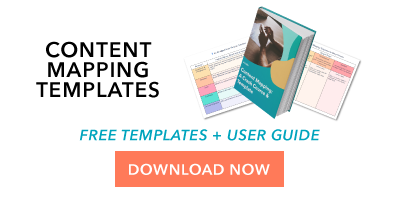Let’s get started.
Why are content maps important?
Creating a content map is important because it personalizes your audience’s experience with your brand. They’re not receiving a one-messaging-fits-all offer or email. Instead, they get content that speaks to them at the right moment.
The idea of a content map may seem new, but it’s not. Marketers hear it all the time: The content you create needs to be personalized. It needs to be aligned with the wants and needs of your customers (and prospective customers). It needs to resonate with them. It needs to feel like it was created just for them.
On its surface, this sounds like great advice. Personalization, giving people content that they’re actually interested in … it makes perfect sense. But coming up with the actual topics that make for a highly targeted content strategy isn’t that easy.
To help you brainstorm and map out content ideas for targeting specific segments of your audience, we’ve created a new free template resource: Content Mapping Template: Using Buyer Personas & Lifecycle Stages to Create Targeted Content.
Download Your Free Template Now
I’ll talk more about how you can use this template in a bit. But first, let’s take a look at how this whole “content mapping” business works.
And when you have this concept down, you’ll want to check out HubSpot Academy’s free content marketing training resource page to learn how to map a content strategy for your business.
Content mapping supports the customer journey and creates a more cohesive, personalized customer experience.
When it comes to content, one size rarely fits all. To ensure that your company’s content is effective at generating and nurturing leads, you need to deliver the right content, to the right people, at the right time. Content mapping is the process of doing just that.
With content mapping, the goal is to target content according to:
- A buyer persona, e.g. The characteristics of the person who will be consuming the content.
- The buyer’s lifecycle stage, e.g. how close that person is to making a purchase.
Let’s go over these two qualities right now.
Buyer Personas
Buyer personas are fictional, generalized representations of your ideal customers. They help you understand your customers (and prospective customers) better, and make it easier for you to tailor content to the specific needs, behaviors, and concerns of different groups.
The strongest buyer personas are based on market research as well as on insights you gather from your actual customer base (through surveys, interviews, etc.). Depending on your business, you could have as few as one or two personas, or dozens. If you’re just getting started with personas, don’t go crazy! You can always develop more personas later if needed.
Lifecycle Stages
The buyer persona you target with your content is just one half of the content mapping equation. In addition to knowing who someone is, you need to know where they are in the buying cycle (i.e. how close they are to making a purchase). This location in the buying cycle is known as a lifecycle stage.
For the purposes of our Content Mapping Template, we’re divvying up the buying cycle into three lifecycle stages: Awareness, Consideration, & Decision.
- Awareness: In the awareness stage, a person has realized and expressed symptoms of a potential problem or opportunity.
- Consideration: In the consideration stage, a person has clearly defined and given a name to their problem or opportunity.
- Decision: In the decision stage, a person has defined their solution strategy, method, or approach.
By combining buyer personas with lifecycle stages, you can really hone in on specific segments of your audience and tailor content to resonate with each of those segments.
As you get more acquainted with content mapping, you’ll want to consider website content mapping as well.
Website Content Mapping
Website content mapping is the process of planning the pages, blog posts, and offers you’ll publish on your site and identifying which buyer personas those pages and posts will serve. Website content mapping also identifies which pages and posts address different lifecycle stages.
Website content mapping is a key element of website personalization. In essence, you’ll create different pages, posts, and offers to address different buyers at different points in the buyer’s journey.
But before you can write all of that content, the content map comes first. Luckily, you don’t have to create one from scratch.
With the right content mapping template, you can get create a content map that resonates with your audience.
Content Mapping Template
Download Your Free Template Now
To help you create a content map for your own team, we’ve created a downloadable content mapping template. The template includes an introduction to content mapping, a crash course on buyer personas and lifecycle stages, a content mapping template (plus examples), and bonus buyer persona templates.
With the template, you’ll:
- Learn how to understand buyer personas and lifecycle stages.
- Identify problems and opportunities that your audience needs help with.
- Brainstorm highly targeted content ideas that incorporate personas and lifecycle stages.
This template is available in both Google Docs and Microsoft Word.
Whether you want to download our content mapping template or create your own, let’s dive into the structure of a content mapping template.
HubSpot Content Mapping Template: How to Use
In our content mapping template, we created a simple grid system. The buyer persona (and a key problem or opportunity that persona is struggling with) is at the start of the grid. As you move from left to right, you’re effectively moving down the funnel.
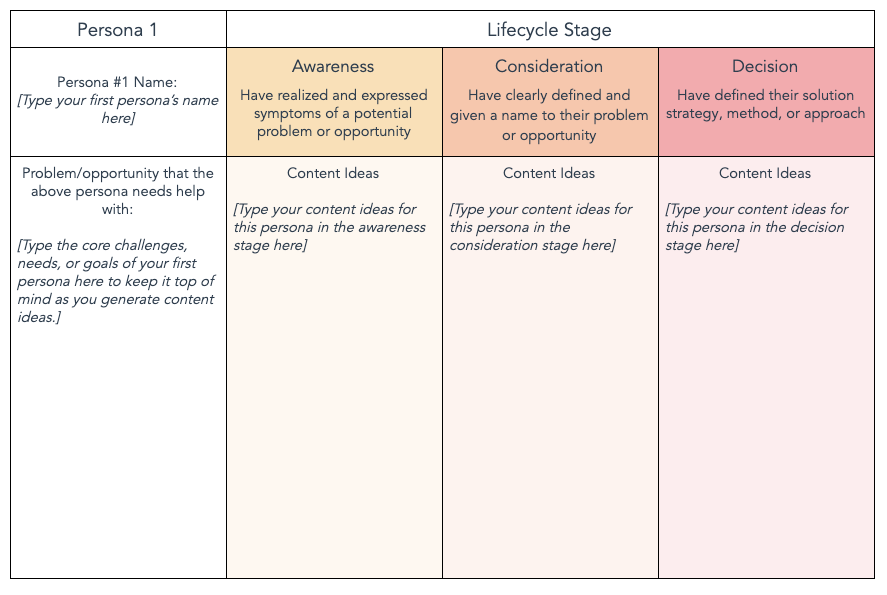
Here’s how to fill out each of the sections in the template.
Awareness Stage Content
Your awareness stage content should target the top of the funnel (TOFU). People in this segment are just becoming aware that they have a problem. At this stage, don’t try to beat them over the head with product-focused content. Instead, think of how your content can help people become more informed about the problem in general, and you’ll (hopefully) find that they continue moving down your funnel as they search for solutions.
Consideration Stage Content
Your consideration stage content, in comparison, can more explicitly mention how your product or service could potentially solve a problem. Keep in mind, however, that at this point in the buying cycle, people are still evaluating their options. So while case studies and demo videos are fine, save your more sales-focused content (estimates, free trials, etc.) for the next stage.
Decision Stage Content
At the decision stage of the game, you can really lean into marketing your products or services. If someone has reached this stage, they’ve already identified a problem and a solution, and are now getting ready to pull the proverbial trigger. You can begin to send more “salesy” emails and offers that push the buyer toward a purchase decision.
Unsure of what this all can look like when put together? Let’s take a look at an example below.
Content Mapping Example
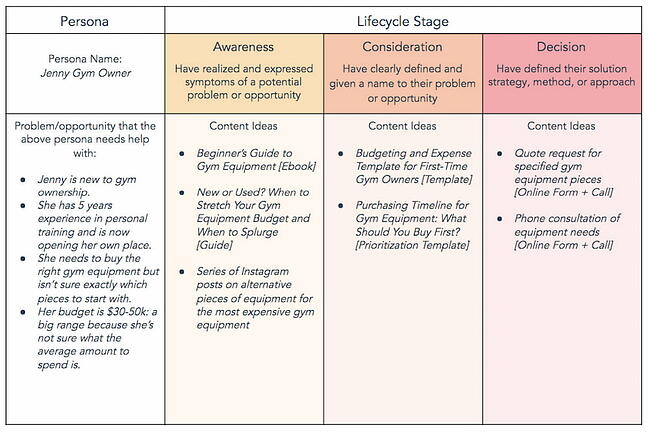
You now know what content mapping is, and you have the template you need to get started. What type of tools can you use to start content mapping?
Content Mapping Tools
Content mapping may seem like a difficult task that requires highly specialized software. It’s not true — it requires simple business tools you may already be using in your day-to-day.
We’ll start with the most basic tools you need to start content mapping, such as word processors and visualization tools. Then we’ll move into the tools that will get you the data that you need to address different buyers, such as a CRM.
1. Google Docs
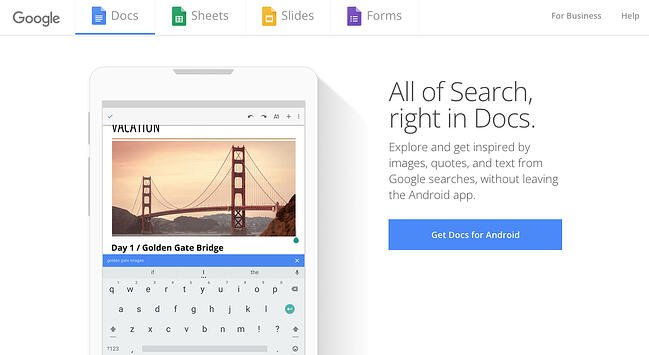
First up in your content mapping tech stack is your preferred word processor. This is where you’ll outline your content map and write out the actual content once it’s time to create it. We highly recommend Google Docs because it makes it easier to share work across your team, and you never have to worry about backing up your content map.
Pricing: Free
2. Lucidchart
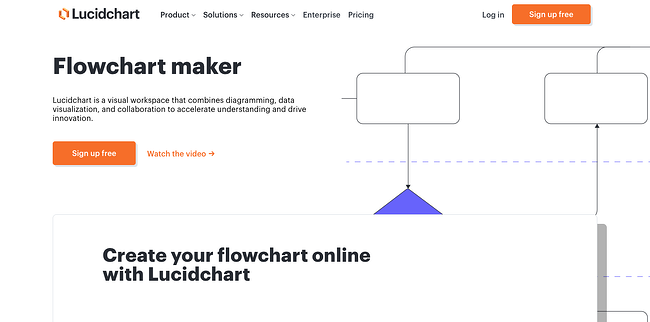
If you’re more of a visual person, then a flowchart tool is a must. Also, if you’d prefer to create an actual content map — with lines and diagrams — then you need a more sophisticated tool than Microsoft Paint (and Microsoft Paint is great, but it may not be what you need). Lucidchart’s flowchart maker is a top-of-the-line tool that also allows you to connect different apps and services. Like Google Docs, it allows you to work collaboratively.
Pricing: Free; $7.95/month (Individual); $9/month (Team); Custom (Enterprise)
3. HubSpot
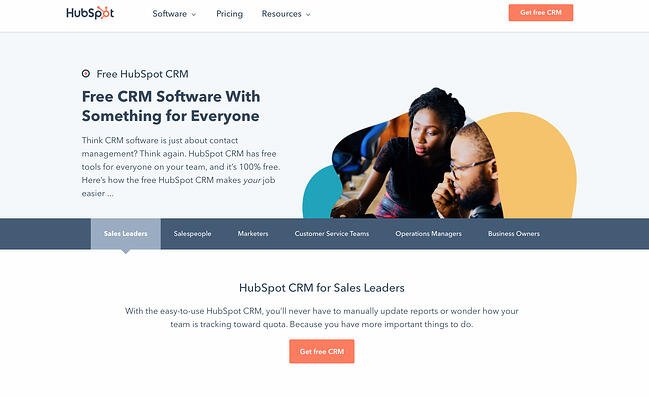 HubSpot’s CRM is the one tool you need to compile all of your data from current and prospective customers. You’ll have access to names, emails, prior engagements, and website visits all in one intuitive place. HubSpot will allow you to discern different lifecycle stages and pinpoint commonalities between customers who are ready to purchase — and customers who are not. As such, you’ll be able to make data-driven decisions as you create your content map.
HubSpot’s CRM is the one tool you need to compile all of your data from current and prospective customers. You’ll have access to names, emails, prior engagements, and website visits all in one intuitive place. HubSpot will allow you to discern different lifecycle stages and pinpoint commonalities between customers who are ready to purchase — and customers who are not. As such, you’ll be able to make data-driven decisions as you create your content map.
Pricing: Free
4. Marketing Hub
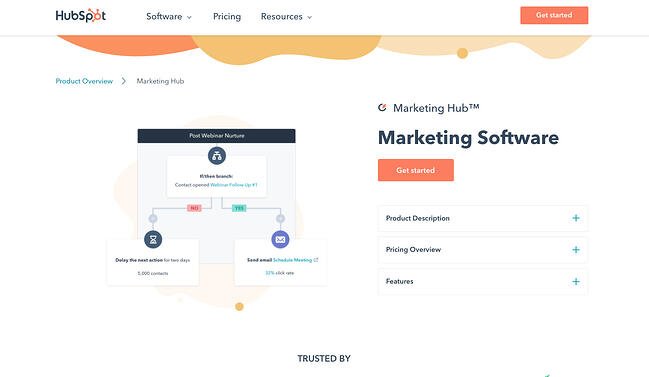
Once you have access to the customer data that you need, it’s time to write the content and distribute it. For that, you need a marketing automation tool. Marking Hub comes bundled with everything you need to create a personalized experience for your leads and prospects, such as email marketing tools. It’ll help you execute your content map once it’s ready for deployment.
Pricing: $0/month (Free); $45/month (Starter); $800/month (Professional); $3,200/month (Enterprise)
5. CMS Hub
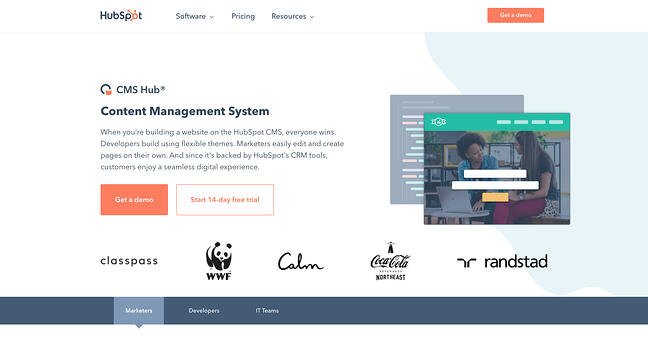
A content management system is probably the most important tool for your content mapping efforts. A CMS will allow you to publish personalized content that targets different site visitors at — you guessed it — different stages of the buyer’s journey.
CMS Hub is fully integrated with HubSpot’s CRM platform and Marketing Hub, allowing you to create a seamless experience for your customers as they receive the content you’ve designed for them. It will help you execute your content map flawlessly. Even more importantly, with CMS Hub, you can continue testing and re-testing your content for better results.
Pricing: $23/month (Starter); $360/month (Professional); $1,200/month (Enterprise)
Not quite convinced that content mapping is worth it? Let’s hear from some marketers who are actually doing this stuff …
Content Mapping Tips From the Pros
1. Educate your audience.
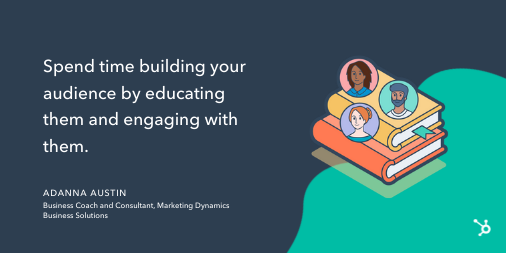 “We all have to create compelling content to attract our ideal clients, build an active and engaged audience, and get daily sales. Spend time building your audience by educating them and engaging with them. No one has built a business by posting the same image or type of image everyday on socials and not having convoys with their audience. It is not just about showing up, but doing so with intention so you can attract your ideal clients who will buy from you.”
“We all have to create compelling content to attract our ideal clients, build an active and engaged audience, and get daily sales. Spend time building your audience by educating them and engaging with them. No one has built a business by posting the same image or type of image everyday on socials and not having convoys with their audience. It is not just about showing up, but doing so with intention so you can attract your ideal clients who will buy from you.”
– Adanna Austin (Business Coach and Consultant, Marketing Dynamics Business Solutions)
2. Give your prospects the information they need before they ask for it.
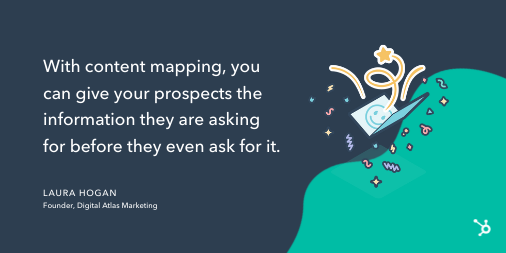 “With content mapping, you can give your prospects the information they are asking for before they even ask for it. Buyer personas and lifecycle stages allow you to be one step ahead of the game by mapping out what your prospect’s next steps are and delivering them the content from numerous different avenues.
“With content mapping, you can give your prospects the information they are asking for before they even ask for it. Buyer personas and lifecycle stages allow you to be one step ahead of the game by mapping out what your prospect’s next steps are and delivering them the content from numerous different avenues.
We create buyer personas as part of our onboarding process and everything we do from content offer to daily tweets is centered around that document. We also always ask ourselves, ‘Would business owner Bob open this email, click this tweet, or download this offer?'”
– Laura Hogan (Founder, Digital Atlas Marketing)
3. Provide different conversion paths for different personas.
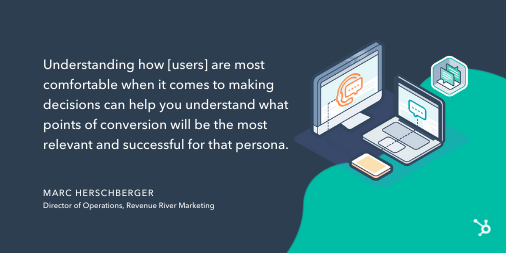 “When mapping out content for your site’s visitors, it’s important to remember that when it comes to purchasing decisions (BOFU conversions, especially for B2B and high-priced items), there are some personas out there who would rather speak to someone on their terms rather than fill out a form for a consultation. Understanding how they are most comfortable when it comes to making decisions can help you understand what points of conversion will be the most relevant and successful for that persona.
“When mapping out content for your site’s visitors, it’s important to remember that when it comes to purchasing decisions (BOFU conversions, especially for B2B and high-priced items), there are some personas out there who would rather speak to someone on their terms rather than fill out a form for a consultation. Understanding how they are most comfortable when it comes to making decisions can help you understand what points of conversion will be the most relevant and successful for that persona.
Optimizing your site pages (landing and thank you pages, as well), TOFU & MOFU offers, and workflows with direct contact information (phone #, email, etc.) is a great way to ensure that visitors, prospects and leads who may shy away from form submissions still have readily available, alternate means of converting.”
– Marc Herschberger (Director of Operations, Revenue River Marketing)
4. Create specific content that appeals to specific personas.
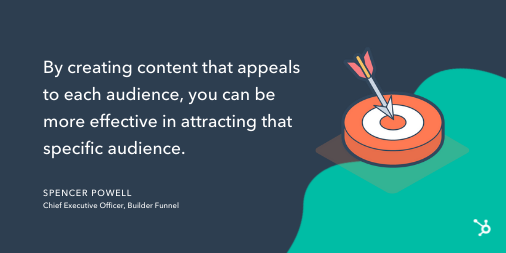 “Mapping out buyer personas and lifecycle stages is extremely important when creating content. In terms of buyer personas, it’s easy to see that a Marketing Director will have different questions, information needs, and interests compared to a CEO. Both of these personas may be searching for your product or service, but they’ll be looking for different topics. By creating content that appeals to each audience, you can be more effective in attracting that specific audience.
“Mapping out buyer personas and lifecycle stages is extremely important when creating content. In terms of buyer personas, it’s easy to see that a Marketing Director will have different questions, information needs, and interests compared to a CEO. Both of these personas may be searching for your product or service, but they’ll be looking for different topics. By creating content that appeals to each audience, you can be more effective in attracting that specific audience.
By the same token, each persona of yours may be in a different stage of the buying process, so it’s important to think through and create content that appeals to someone looking for basic, high-level information such as an ebook, as well as specific information like a pricing guide or case study.
One tip I’d suggest for anyone with pretty different personas would be to dedicate an entire section of your site to each audience. That way, when you pull in your audience, all the content is directed toward them.
We actually took this concept and went a step further by creating unique brands for each one of our vertical markets. Each brand has its own section of the website, its own blog content, and its own premium content (downloadable offers). It’s really helped us attract and convert visitors at a higher rate because all the content is more relevant to that persona.”
– Spencer Powell (Chief Executive Officer, Builder Funnel)
4. Pull content topics from your sales process.
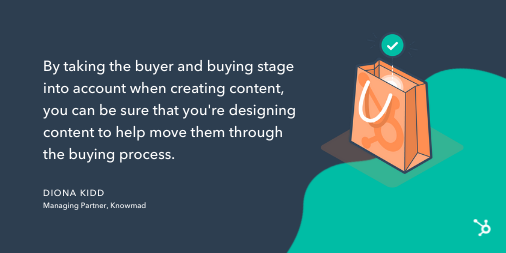 “By taking the buyer and buying stage into account when creating content, you can be sure that you’re designing content to help move them through the buying process.
“By taking the buyer and buying stage into account when creating content, you can be sure that you’re designing content to help move them through the buying process.
In addition to mapping content to the buyer profile and buying stage, we regularly pull topics from the sales process. Then we offer the content in later sales calls. This helps us not only evaluate the relevancy of the content but also the interest of the buyer. We encourage clients to do the same.”
– Diona Kidd (Managing Partner, Knowmad)
Content Mapping is Key to Your Company’s Growth
Delivering the right content at the right time can do wonders for your company’s growth. By meeting prospects’ needs based on their persona and lifecycle stage, you’re delighting them at every turn, boosting your chances of winning a loyal customer and turning them into a brand evangelist.
Editor’s Note: This post was originally published in March 2014 and has been updated for accuracy and comprehensiveness.
![]()




